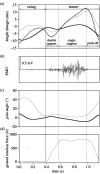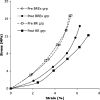Human tendon behaviour and adaptation, in vivo
- PMID: 17855761
- PMCID: PMC2375561
- DOI: 10.1113/jphysiol.2007.139105
Human tendon behaviour and adaptation, in vivo
Abstract
Tendon properties contribute to the complex interaction of the central nervous system, muscle-tendon unit and bony structures to produce joint movement. Until recently limited information on human tendon behaviour in vivo was available; however, novel methodological advancements have enabled new insights to be gained in this area. The present review summarizes the progress made with respect to human tendon and aponeurosis function in vivo, and how tendons adapt to ageing, loading and unloading conditions. During low tensile loading or with passive lengthening not only the muscle is elongated, but also the tendon undergoes significant length changes, which may have implications for reflex responses. During active loading, the length change of the tendon far exceeds that of the aponeurosis, indicating that the aponeurosis may more effectively transfer force onto the tendon, which lengthens and stores elastic energy subsequently released during unloading, in a spring-like manner. In fact, data recently obtained in vivo confirm that, during walking, the human Achilles tendon provides elastic strain energy that can decrease the energy cost of locomotion. Also, new experimental evidence shows that, contrary to earlier beliefs, the metabolic activity in human tendon is remarkably high and this affords the tendon the ability to adapt to changing demands. With ageing and disuse there is a reduction in tendon stiffness, which can be mitigated with resistance exercises. Such adaptations seem advantageous for maintaining movement rapidity, reducing tendon stress and risk of injury, and possibly, for enabling muscles to operate closer to the optimum region of the length-tension relationship.
Figures







Similar articles
-
Effects of muscle contraction on the load-strain properties of frog aponeurosis and tendon.Cells Tissues Organs. 2000;166(1):48-54. doi: 10.1159/000016708. Cells Tissues Organs. 2000. PMID: 10671755
-
Muscle-tendon length and force affect human tibialis anterior central aponeurosis stiffness in vivo.Proc Natl Acad Sci U S A. 2018 Apr 3;115(14):E3097-E3105. doi: 10.1073/pnas.1712697115. Epub 2018 Mar 19. Proc Natl Acad Sci U S A. 2018. PMID: 29555756 Free PMC article.
-
Aponeurosis behaviour during muscular contraction: A narrative review.Eur J Sport Sci. 2018 Sep;18(8):1128-1138. doi: 10.1080/17461391.2018.1472299. Epub 2018 May 28. Eur J Sport Sci. 2018. PMID: 29806988 Review.
-
In vivo muscle function vs speed. I. Muscle strain in relation to length change of the muscle-tendon unit.J Exp Biol. 2005 Mar;208(Pt 6):1175-90. doi: 10.1242/jeb.01486. J Exp Biol. 2005. PMID: 15767316
-
Ageing of human muscles and tendons.Disabil Rehabil. 2008;30(20-22):1548-54. doi: 10.1080/09638280701831058. Disabil Rehabil. 2008. PMID: 18608375 Review.
Cited by
-
Continuum model of tendon pathology - where are we now?Int J Exp Pathol. 2013 Aug;94(4):242-7. doi: 10.1111/iep.12029. Int J Exp Pathol. 2013. PMID: 23837792 Free PMC article. Review.
-
Adaptive Remodeling of Achilles Tendon: A Multi-scale Computational Model.PLoS Comput Biol. 2016 Sep 29;12(9):e1005106. doi: 10.1371/journal.pcbi.1005106. eCollection 2016 Sep. PLoS Comput Biol. 2016. PMID: 27684554 Free PMC article.
-
Jump training with blood flow restriction has no effect on jump performance.Biol Sport. 2018 Dec;35(4):343-348. doi: 10.5114/biolsport.2018.78053. Epub 2018 Aug 31. Biol Sport. 2018. PMID: 30765919 Free PMC article.
-
Body mass maximizes power output in human jumping: a strength-independent optimum loading behavior.Eur J Appl Physiol. 2013 Dec;113(12):2913-23. doi: 10.1007/s00421-013-2707-7. Epub 2013 Aug 13. Eur J Appl Physiol. 2013. PMID: 23943265 Review.
-
Quadriceps strength, patellar tendon quality, relative load exposure, and knee symptoms in male athletes before the anterior cruciate ligament reconstruction.Front Rehabil Sci. 2023 Oct 19;4:1283635. doi: 10.3389/fresc.2023.1283635. eCollection 2023. Front Rehabil Sci. 2023. PMID: 37928751 Free PMC article.
References
-
- Alexander RM. Energy-saving mechanisms in walking and running. J Exp Biol. 1991;160:55–69. - PubMed
-
- Alexander RM, Bennet-Clark HC. Storage of elastic strain energy in muscle and other tissues. Nature. 1977;265:114–117. - PubMed
-
- Arampatzis A, Stafilidis S, DeMonte G, Karamanidis K, Morey-Klapsing G, Bruggemann GP. Strain and elongation of the human gastrocnemius tendon and aponeurosis during maximal plantarflexion effort. J Biomech. 2005;38:833–841. - PubMed
-
- Arndt AN, Bruggemann GP, Koebke J, Segesser B. Asymmetrical loading of the human tricpes surae. I. Mediolateral force difference in the Achilles tendon. Foot Ankle Int. 1999;20:445–449. - PubMed
-
- Arnoczky SP, Lavagnino M, Whallon JH, Hoonjan A. In situ cell nucleus deformation in tendons under tensile load; a morphological analysis using confocal laser microscopy. J Orthop Res. 2002;20:29–35. - PubMed
Publication types
MeSH terms
LinkOut - more resources
Full Text Sources
Medical

